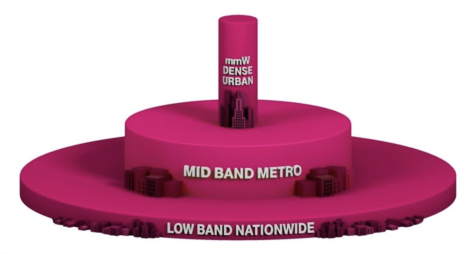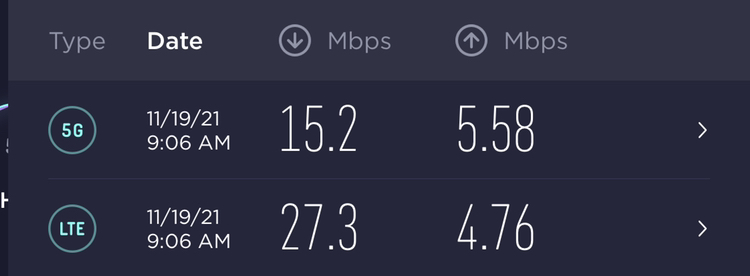5G Could Be Making your Phone Slower
It’s not just you: that 5G badge on your phone often does not make a noticeable difference in performance. In fact, it’s common for 5G to actually be slower than 4G LTE. 5G has been marketed as the new, revolutionary cellular technology that promises to bring new opportunities and advancements. While that is true, it is taking too long for these promises to be fulfilled, at least in the United States. AT&T even rebranded their LTE product as “5GE” in some cities—giving the illusion that customers have 5G on their phone (they were sued). In other countries such as Taiwan and South Korea, cellular companies were quick to the race, bringing revolutionary speeds across their respective nations. The US is far behind in the race of 5G, and the root of our slow development is in federal regulations.
First and foremost, it is important to know what 5G actually is and how it works. 5G is the fifth generation of cellular technology, bringing new advancements its predecessors don’t have. 5G promises to bring unprecedented network capacity, ultra-low latency, and increased reliability and performance. 5G also brings different spectrums and wider bandwidth compared to previous generations, allowing plenty of room for future growth.

There are three different subtypes of 5G: low-band, mid-band, and millimeter-wave (mmWave) 5G. This wide range of frequencies is part of what gives 5G its performance and reliability. Each serves a different purpose, and they all work in conjunction to bring reliable speeds everywhere you go. Low-band 5G operates on lower frequencies, commonly around 600-850 MHz. Low-band has excellent range but doesn’t have great performance compared to the higher frequencies, mid-band and mmWave. MmWave, unlike low-band, has incredible performance but suffers from its incredibly short range. It is only accessible when positioned very close to the node. Mid-band is a good spot in the middle, combining good range with good performance—the best of both worlds. Working together, low-band can provide for more rural areas, mid-band will work great in urban or suburban areas, and mmWave will provide for dense urban areas.
 The problem with 5G in the US is the slow rollout due to Federal Communications Commission (FCC) spectrum auctions. Because everybody can’t use the same frequencies and spectrums because of scarcity and interference, the FCC must auction off these frequencies to ensure spectrums don’t collide and interfere. Since mid-band is a high-in-demand spectrum due to its mix of good range and good speed, carriers are willing to fiercely compete for it. Companies like Verizon spent up to $45B for this precious slice of spectrum. Also, to make room for 5G usage on mid-band frequencies, satellite television operators had to slowly move off those frequencies. Additionally, the access of mid-band will be a slow rollout in waves guided by the FCC. In other words, the rollout of mid-band will take several years, meaning that only low-band and mmWave 5G are currently in use in the US. In other countries, 5G mid-band has become readily available for use by cellular carriers and has been rolled out widely, bringing all three layers of the spectrum cake nationwide in those countries.
The problem with 5G in the US is the slow rollout due to Federal Communications Commission (FCC) spectrum auctions. Because everybody can’t use the same frequencies and spectrums because of scarcity and interference, the FCC must auction off these frequencies to ensure spectrums don’t collide and interfere. Since mid-band is a high-in-demand spectrum due to its mix of good range and good speed, carriers are willing to fiercely compete for it. Companies like Verizon spent up to $45B for this precious slice of spectrum. Also, to make room for 5G usage on mid-band frequencies, satellite television operators had to slowly move off those frequencies. Additionally, the access of mid-band will be a slow rollout in waves guided by the FCC. In other words, the rollout of mid-band will take several years, meaning that only low-band and mmWave 5G are currently in use in the US. In other countries, 5G mid-band has become readily available for use by cellular carriers and has been rolled out widely, bringing all three layers of the spectrum cake nationwide in those countries.
5G promises to bring great things to the world of telecommunications and beyond. But, those promises are slow to come because of the management and regulation we have in the US. The numerous cellular carriers wanting the valuable and scarce mid-band spectrum make for tight auctions that take time to process. Additionally, the slow rollout of mid-band spectrum by the FCC adds additional time to our 5G timeline. Other countries don’t have the same obstacles that we do, making the US fall behind in the cellular industry.
Extra: Here is a speed test in the Keystone fishbowl using AT&T. As you can see, the 5G is almost 2x slower.


Cody is a senior and is actively involved in Keynote, NHS, Robotics, and Yearbook. He is the co-editor of Yearbook in addition to being Co-Editor...


Cody • Nov 19, 2021 at 9:11 am
Speedtest at Keystone Fishbowl
5G – 15.2mbps down, 5mbps up
LTE – 27.3mbps down, 4.7mbps up
5G is slower on Keystone campus!